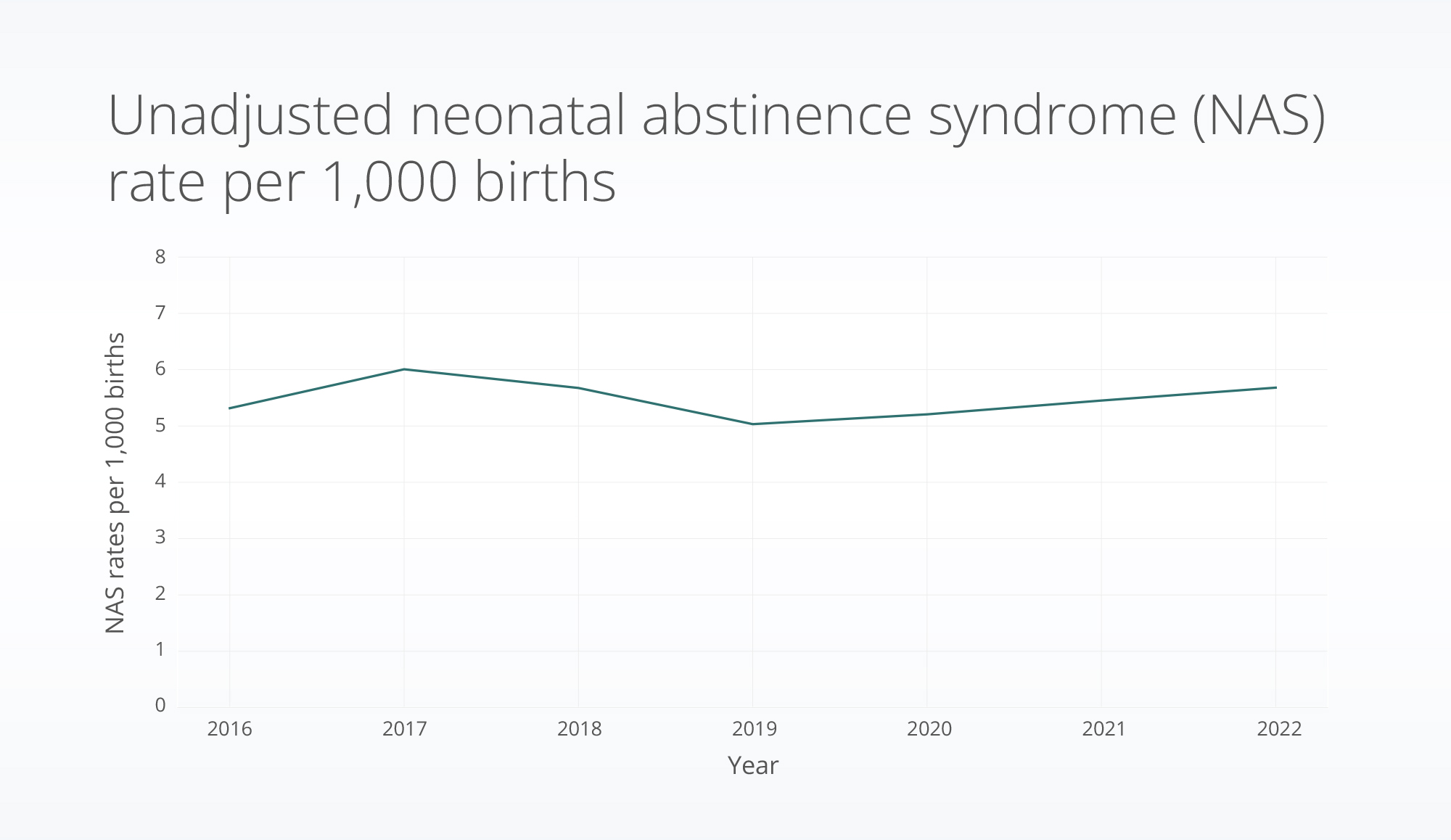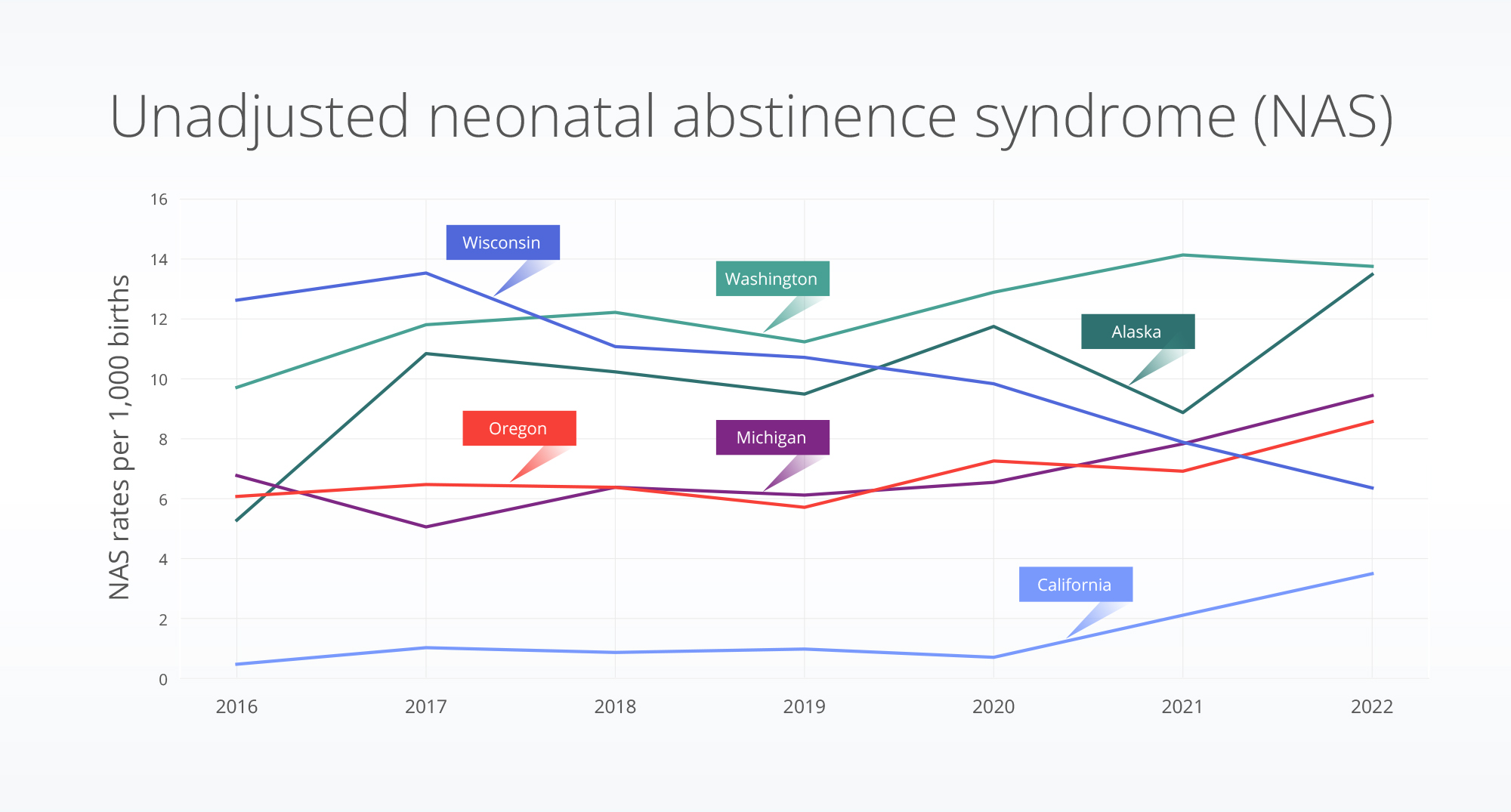Since the 1990s, the negative impact of prescription opioids – particularly death from overdose – have become an epidemic in the US (Centers for Disease Control and Prevention, 2022; Paulozzi et al., 2011). More recently, in the early 2010s, the US embarked on a new wave of the epidemic with the increase in prescriptions of synthetic opioids, such as fentanyl (Centers for Disease Control and Prevention, 2022). This was followed by an increase in overdose deaths across the US, specifically in West and Mid-west regions (Hernández et al., 2021). In 2022, the CDC reported that 187 people die every day from an opioid overdose (Centers for Disease Control and Prevention, 2022; Larson et al., 2019).
Published articles have not only showed variation in which age and sex groups have the highest death rates (Hernández et al., 2021), but also the effect on pregnant women and their babies. Opioid use during pregnancy puts the infant at risk of preterm birth, low birth weight, neonatal abstinence syndrome (NAS), and the potential for neurocognitive, behavioral, and developmental impacts later in life (Centers for Disease Control and Prevention, 2018). The CDC reports that the rate of infants exposed to opioids in utero has dramatically increased, as evidenced by the four-fold increase in NAS diagnosis rate from 1999 to 2014 (Centers for Disease Control and Prevention, 2018).
Although many states report opioid-associated overdoses and deaths, there is minimal data available on state-specific rates of NAS. One study using claims data shows state-level trends through 2017, but not beyond (Hirai et al., 2021). Given reports that the COVID-19 pandemic accelerated the already worsening opioid epidemic, we were interested to dig into the effects of this on newborns (Centers for Disease Control and Prevention, 2020). We worked exclusively with Julie Wernau from the Wall Street Journal to explore recent trends in state level rates of NAS.
Methods
We looked at a subset of Truveta data, including over 1.3 million births between 2016 and 2022, to calculate the NAS rate across a series of states. NAS was defined using a similar strategy to Hirai et. al.; however, we added two additional SNOMED codes to the definition (Hirai et al., 2021).
The rates are unadjusted, meaning we did not account for potential differences in the population within the Truveta data and the state or US population.
Results
Of the 1.3 million births we looked at, over 7,000 infants were diagnosed with NAS. We saw a decrease in rates from 2017 to 2019, with increasing rates from 2019 to 2022. Between 2016 and 2022, all rates ranged between 5.0 (in 2019) and 6.0 (in 2017) NAS events per 1,000 births.

We also looked at NAS rates across six individual states of interest (California, Wisconsin, Washington, Alaska, Oregon, and Michigan).
Although the unadjusted NAS rates for California are low, we see an increase in the NAS rate since 2020. We see a decrease in rates in Wisconsin since 2017, while rates in Washington and Oregon appear to be increasing since 2019. Michigan rates also seem to be increasing since 2020. Alaska has yearly variation in the NAS rates.

Discussion
Overall, the variation in state-level data is interesting and may inform state-level best practices.
We found many of the state-level trends in our data correlated with state-reported trends of opioid use and opioid-related deaths. For example, the state of California shows an increase in opioid related deaths during the same time that we see an increase in NAS rates in our data (California Department of Public Health, 2023). This is similar in Washington, Oregon, and Michigan, where state reported data shows in increase in opioid-related deaths during the same time period that we see increases in NAS rates (Kent, 2020; Oregon Health Authority, 2020; State of Michigan, 2023; University of Washington, 2023).
Alaska has yearly variation in NAS rates. This aligns with overdose-related death rates reported by the state (Rosen & Beacon, 2022). The increase we see in NAS rates in 2022 may correlate with the increase in opioid-related deaths in 2021, as there may be up to a 9-month lag between these two measures.
Wisconsin showed a decrease in NAS rates, which was not seen in other states. We looked at public records to understand this trend and found that Wisconsin implemented new required training related to opioid prescribing guidelines in 2017 (WisBusiness, 2019). We also found that the state reported an overall decrease in the rate of opioid-related deaths from 2017-2019 (although the state did report that the rate of opioid-related deaths between 2018-2019 increased) (Wisconsin Department of Health Services, 2022). This may indicate that some policies and training may affect the rate of NAS.
There are a few limitations associated with this study. First, no statistical analyses were conducted. This affects this study in two ways: 1) we did not take into account potential differences between the underlying Truveta data and the data in the US/states of interest and 2) we did not test for significance in the increases or decreases we see in the rates; we are only describing the visual trends. We used a definition for NAS found in one peer-reviewed article (Hirai et al., 2021), however there may be additional ways to define NAS, either using additional ICD-10 codes or looking at the presence of Finnegan scores, which are used to assess the presence and severity of NAS symptoms in newborns (Goyal et al., 2020). Finally, NAS is a general term used to describe withdrawal symptoms from in utero exposure to a multitude of drugs, including but not limited to opioids.. While we are drawing a connection between opioid use trends and NAS, not all NAS is caused by opioid exposure, though a recent analysis by Goyel et al., demonstrated up to 98% of cases were linked to maternal opioid exposure (Goyal et al., 2020).
You can read the Wall Street Journal analysis on this topic here: For Babies Born Dependent on Opioids, Doctors Try New Caregiving Approach – WSJ
These are preliminary research findings and not peer reviewed. Data are constantly changing and updating. These findings are consistent with data pulled February, 1, 2023.
Citations
California Department Of Public Health. (2023, February 15). California Overdose Surveillance Dashboard. https://skylab.cdph.ca.gov/ODdash/?tab=CA
Centers for Disease Control and Prevention. (2018, August 9). The US Opioid Crisis: Addressing Maternal and Infant Health. Reproductive Health. https://www.cdc.gov/reproductivehealth/maternalinfanthealth/substance-abuse/opioid-use-disorder-pregnancy/index.html
Centers for Disease Control and Prevention. (2020, December 17). Overdose Deaths Accelerating During COVID-19. CDC Newsroom Releases. https://www.cdc.gov/media/releases/2020/p1218-overdose-deaths-covid-19.html
Centers for Disease Control and Prevention. (2022, June 1). Understanding the Opioid Overdose Epidemic. Opioids. https://www.cdc.gov/opioids/basics/epidemic.html
Goyal, S., Saunders, K. C., Moore, C. S., Fillo, K. T., Ko, J. Y., Manning, S. E., Shapiro-Mendoza, C., Gupta, M., Romero, L., Coy, K. C., McDow, K. B., Keaton, A. A., Sinatra, J., Jones, K., Alpren, C., Barfield, W. D., & Diop, H. (2020). Identification of Substance-Exposed Newborns and Neonatal Abstinence Syndrome Using ICD-10-CM — 15 Hospitals, Massachusetts, 2017. MMWR. Morbidity and Mortality Weekly Report, 69(29), 951–955. https://doi.org/10.15585/mmwr.mm6929a2
Hernández, A., Lan, M., MacKinnon, N. J., Branscum, A. J., & Cuadros, D. F. (2021). “Know your epidemic, know your response”: Epidemiological assessment of the substance use disorder crisis in the United States. PLOS ONE, 16(5), e0251502. https://doi.org/10.1371/journal.pone.0251502
Hirai, A. H., Ko, J. Y., Owens, P. L., Stocks, C., & Patrick, S. W. (2021). Neonatal Abstinence Syndrome and Maternal Opioid-Related Diagnoses in the US, 2010-2017. JAMA, 325(2), 146. https://doi.org/10.1001/jama.2020.24991
Kent, J. (2020, October 26). Real-Time Data Shows Opioid Overdoses Increased During Pandemic. TechTarget Health IT Analytics. https://healthitanalytics.com/news/real-time-data-shows-opioid-overdoses-increased-during-pandemic
Larson, J. J., Graham, D. L., Singer, L. T., Beckwith, A. M., Terplan, M., Davis, J. M., Martinez, J., & Bada, H. S. (2019). Cognitive and Behavioral Impact on Children Exposed to Opioids During Pregnancy. Pediatrics, 144(2), e20190514. https://doi.org/10.1542/peds.2019-0514
Oregon Health Authority. (2020, December 23). Oregon trends with U.S. in accelerated drug overdoses. https://www.oregon.gov/oha/ERD/Pages/Oregon-trends-with-U.S.-in-accelerated-drug-overdoses.aspx
Paulozzi, L. J., Jones, C. M., Mack, K. A., & Rudd, R. A. (2011). Vital Signs: Overdoses of Prescription Opioid Pain Relievers—United States, 1999—2008. Morbidity and Mortality Weekly Report (MMWR), 60(43), 1487–1492.
Rosen, Y., & Beacon, A. (2022, August 1). Report details Alaska demographics hurt most by 2021 spike in drug-overdose deaths. https://alaskapublic.org/2022/08/01/report-details-alaska-demographics-hurt-most-by-2021-spike-in-drug-overdose-deaths/
State of Michigan. (2023). Opioid Resources. https://www.michigan.gov/opioids/category-data
University of Washington. (2023, January 13). Opioid trends across Washington State. Addictions, Drug & Alcohol Institue, University of Washignton. https://adai.washington.edu/WAdata/deaths.htm
WisBusiness. (2019, August 1). State policy changes coincided with opioid prescription reductions, report shows. https://www.wisbusiness.com/2019/state-policy-changes-coincided-with-opioid-prescription-reductions-report-shows/
Wisconsin Department of Health Services. (2022, June 8). Dose of Reality: Opioid Data Summary Dashboard. https://dhs.wisconsin.gov/opioids/dashboards.htm
